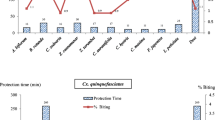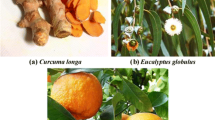Abstract
The behavioral effects of four essential oils extracted from orange peel (Citrus aurantium L.), cinnamon leaf (Cinnamomum verum J. Presl), citronella grass (Cymbopogon winterianus Jowitt), and clove flower [Syzygium aromaticum (L.) Merrill & Perry] were evaluated against two medically important species of mosquitoes, Aedes aegypti (L.) and Culex quinquefasciatus Say, using an excito-repellency test system. Ae. aegypti was collected from a small village in Kanchanaburi Province and Culex quinquefasciatus was captured from an urban area of Bangkok. Mosquitoes from the F1–F3 generations were tested in the excito-repellency test chamber for contact excitation and non-contact spatial repellency. Results showed that both species demonstrated varying levels of behavioral escape responses to different essential oils, showing a clear dose response depending on percent w/v concentration used. Orange oil produced the least response in both mosquito species, while citronella and clove the greatest. In general, Cx. quinquefasciatus exhibited much stronger behavioral responses to all four essential oils than Ae. aegypti. From this study, we conclude that the essential oils from various botanical sources should continue to be screened for protective properties against mosquitoes and other biting arthropods.



Similar content being viewed by others
References
Abbott WS (1925) A method of computing the effectiveness of an insecticide. J Econ Entomol 18:265–267
Adewoyin FB, Odaibo AB, Adewunmi CO (2006) Mosquito-repellent activity of Piper guineense and Xylopia aethiopica fruits oils on Aedes aegypti. Afr J Trad Complem Alter Med 3:79–83
Bernard DR (1999) Repellency of essential oils to mosquitoes (Diptera: Culicidae). J Med Entomol 36:625–629
Brown M, Hebert AA (1997) Insect repellents: an overview. J Am Acad Dermatol 36:243–249
Chokechaijaroenporn O, Bunyapraphatsara N, Kongchuensin S (1994) Mosquito repellent activities of ocimum volatile oils. Phytomedicine 1:135–139
Chareonviriyaphap T, Roberts DR, Andre RG, Harlan H, Manguin S, Bangs MJ (1997) Pesticide avoidance behavior in Anopheles albimanus Wiedemann. J Am Mosq Contr Assoc 13:171–183
Chareonviriyaphap T, Prabaripai A, Sungvornyothin S (2002) An improved excito-repellency for mosquito behavioral test. J Vector Ecol 27:250–252
Chareonviriyaphap T, Prabaripai A, Bangs MJ (2004) Excito-repellency of deltamethrin on the malaria vectors, Anopheles minimus, Anopheles dirus, Anopheles sawadwongporni, and Anopheles maculatus, in Thailand. J Am Mosq Contr Assoc 20:45–54
Chuaycharoensuk T, Juntarajumnong W, Boonyuan W, Bangs MJ, Akratanakul P, Thammapalo S, Jirakanjanakit N, Tanasinchayakul S, Chareonviriyaphap T (2011) Frequency of pyrethroid resistance in Aedes aegypti and Aedes albopictus (Diptera: Culicidae) in Thailand. J Vector Ecol 36:204–212
Coleman RE, Robert LL, Roberts LW, Glass JA, Seeley DC, Laughinghouse A, Perkins PV, Wirtz RA (1993) Laboratory evaluation of repellents against four anopheline mosquitoes (Diptera: Culicidae) and two phlebotomine sand files (Diptera: Psychodidae). J Med Entomol 30:499–502
Debboun M, Frances SP, Strickman D (2007) Insect repellents: principle, methods, and uses. CRC Press, Boca Raton
De Boer H, Vongsombath C, Palsson K, Biork L, Jaenson TG (2010) Botanical repellents and pesticides traditionally used against hematophagous invertebrates in Lao People’s Democratic Republic: a comparative study of plants used in 66 villages. J Med Entomol 47:400–414
Ditzen M, Pellegrino M, Vosshall LB (2008) Insect odorant receptors are molecular targets of the insect repellent DEET. Science 319:1838–1842
Fradin MS, Day JF (2002) Comparative efficacy of insect repellents against mosquito bites. N Engl J Med 347:13–18
Gillij YG, Gleiser RM, Zygadlo JA (2008) Mosquito repellent activity of essential oils of aromatic plants growing in Argentina. Bioresour Technol 99:2507–2515
Grieco JP, Achee NL, Sardelis MR, Chauhan KR, Roberts DR (2005) A novel high throughput screening system to evaluate the behavioral response of adult mosquitoes to chemicals. J Am Mosq Contr Assoc 21:404–411
Grieco JP, Achee NL, Chareonviriyaphap T, Suwonkerd W, Chauhan K, Sardelis MR, Roberts DR (2007) A new classification system for the actions of IRS chemicals traditionally used for malaria control. PLoS ONE 2(8):e716. doi:10.1371/journal.pone.0000716
Kleinbaum DG (1995) Survival analysis. Springer, New York
Kongmee M, Prabaripai A, Akratanakul P, Bangs MJ, Chareonviriyaphap T (2004) Behavioral responses of Aedes aegypti (Diptera: Culicidae) exposed to deltamethrin and possible implications for disease control. J Med Entomol 41:1055–1063
Kumar P, Mishra S, Malik A, Satva S (2011) Repellent, larvicidal and pupicidal properties of essential oils and their formulations against the housefly, Musca domestica. J Med Vet Entomol 25:302–310
McCabe ET, Barthel WF, Gertler SI, Hall SA (1954) Insect repellent III N,N-diethylamides. J Org Chem 19:493–498
Mantel N, Haenzel W (1959) Statistic aspects of the analysis of data from retrospective studies of diseases. J Natl Cancer Inst 22:719–748
Mongkalangoon P, Grieco JP, Achee NL, Suwonkerd W, Chareonviriyaphap T (2009) Irritability and repellency of synthetic pyrethroids on an Aedes aegypti population from Thailand. J Vector Ecol 34:217–224
Noosidum A, Prabaripai A, Chareonviriyaphap T, Chandrapatya A (2008) Excito-repellency properties of essential oils from Melaleuca leucadendron L., Litsea cubeba (Lour.) Persoon, and Litsea salicifolia (Nees) on Aedes aegypti (L.) mosquitoes. J Vector Ecol 33:305–312
Odalo JO, Omolo MO, Malebo H, Angira J, Njeru PM, Ndiege IO, Hassanali A (2005) Repellency of essential oils of some plants from the Kenyan coast against Anopheles gambiae. Acta Tropica 95:210–218
Park BS, Choi WS, Kim JH, Kim KH, Lee SE (2005) Monoterpenes from thyme (Thymus vulgaris) as potential mosquito repellents. J Am Mosq Contr Assoc 21:80–83
Polsomboon S, Grieco JP, Achee NL, Chauhan KR, Tanasinchayakul S, Pothikasikorn J, Chareonviriyaphap T (2008a) Behavioral responses of catnip (Nepeta cataria) by two species of mosquitoes, Aedes aegypti and Anopheles harrisoni, in Thailand. J Am Mosq Contr Assoc 24:513–519
Polsomboon S, Poolprasert E, Bangs MJ, Suwonkerd W, Grieco JP, Achee NL, Prabaripai A, Chareonviriyaphap T (2008b) Effects of physiological conditioning on behavioral avoidance by using a single age group of Aedes aegypti exposed to deltamethrin and DDT. J Med Entomol 45:251–259
Reiter P, Gubler DJ (1997) Surveillance and control of urban dengue vectors. In: Gubler DJ, Kuno G (eds) Dengue and dengue hemorrhagic fever. CABI, Wallington, pp 425–426
Roberts DR, Alecrim WD, Tavares AM, McNeill KM (1984) Influence of physiological condition on the behavioral response of Anopheles darlingi to DDT. Mosq News 44:357–362
Roberts DR, Andre RG (1994) Insecticide resistance issues in vector-borne disease control. Am J Trop Med Hygiene 50:21–34
Roberts DR, Chareonviriyaphap T, Harlan HH, Hshieh P (1997) Methods for testing and analyzing excito-repellency responses of malaria vectors to insecticides. J Am Mosq Contr Assoc 13:13–17
Roberts DR, Alecrim WD, Hshieh P, Grieco JP, Bangs MJ, Andre RG, Chareonviriyaphap T (2000) A probability model of vector behavior: effects of DDT repellency, irritability, and toxicity in malaria control. J Vector Ecol 25:48–61
Rutledge LC, Collister DM, Meixsell VE, Eisenberg GHG (1983) Comparative sensitivity of representative mosquitoes (Diptera: Culicidae) to repellents. J Med Entomol 20:506–510
Rutledge LC, Echana NM, Gupta RK (1999) Responses of male and female mosquitoes to repellents in the World Health Organization insecticide irritability test system. J Am Mosq Contr Assoc 15:60–64
Sasa M (1976) Human filariasis. A global survey of epidemiology and control. University Park Press, Baltimore
Sungvornyothin S, Chareonviriyaphap T, Prabaripai A, Thirakhupt V, Ratanatham S, Bangs MJ (2001) Effects of nutritional and physiological status on behavioral avoidance of Anopheles minimus (Diptera: Culicidae) to DDT, deltamethrin and lambdacyhalothrin. J Vector Ecol 26:202–215
Suwannachote N, Grieco JP, Achee NL, Suwonkerd W, Wongtong S, Chareonviriyaphap T (2009) Effects of environmental conditions on the movement patterns of Aedes aegypti (Diptera: Culicidae) into and out of experimental huts in Thailand. J Vector Ecol 34:267–275
Suwonkerd W, Tantrarongroj K (1994) Efficacy of essential oil against mosquito biting. Commun Dis J 20:4–11
Tawatsin A, Wratten SD, Scott RR, Thavara U, Techadamrongsin Y (2001) Repellency of volatile oils from plants against three mosquito vectors. J Vector Ecol 26:76–82
Tawatsin A, Asavadachanukorn P, Thavara U, Wongsinkongman P, Bansidhi J, Boonruad T, Chavalit-tumrong P, Soonthornchareonnon N, Komalamisra N, Mulla MS (2006) Repellency of essential oils extracted from plants in Thailand against four mosquito vectors (Diptera: Culicidae) and oviposition deterrent effects against Aedes aegypti (Diptera: Culicidae). Southeast Asian J Trop Med Public Health 37:915–931
Thanispong K, Sathantriphop S, Chareonviriyaphap T (2008) Insecticide resistance of Aedes aegypti and Culex quinquefasciatus in Thailand. J Pestic Sci 33:351–356
Thanispong K, Achee NL, Bangs MJ, Grieco JP, Suwonkerd W, Prabaripai A, Chareonviriyaphap T (2009) Irritancy and repellency behavioral responses of three strains of Aedes aegypti exposed to DDT and alpha-cypermethrin. J Med Entomol 46:1407–1414
Thavara U, Tawatsin A, Bhakdeenuan P, Wongsinkongman P, Boonruad T, Bansiddhi J, Chavalittumrong P, Komalamisra N, Siriyasatien P, Mulla MS (2007) Repellent activity of essential oils against cockroaches (Dictyoptera: Blattidae, Blattellidae, and Blaberidae) in Thailand. Southeast Asian J Trop Med Public Health 38:663–673
Trongtokit Y, Rongsriyam Y, Komalamisra N, Krisadaphong P, Apiwathnasorn C (2004) Laboratory and field trial of developing medicinal local Thai plant products against four species of mosquito vectors. Southeast Asian J Trop Med Public Health 35:325–333
Trongtokit Y, Rongsriyam Y, Komalamisra N, Apiwathnasorn C (2005) Comparative repellency of 38 essential oils against mosquito bites. Phytother Res 19:303–309
Tuetun B, Choochote W, Kanjanapothi D, Rattanachanpichai E, Chaithong U, Chaiwong P, Jitpakdit A, Tippawongkosolt P, Riyong D, Pitasawat B (2005) Repellent properties of celery, Apium graveolens L., compared with commercial repellents, against mosquitoes under laboratory and field conditions. Trop Med Int Health 10:1190–1198. doi:10.1111/j.1365-3156.2005.01500.x
Walker TW, Robert LL, Copeland RA, Githeko AK, Wirtz RA, Githure JI, Klein TA (1996) Field evaluation of arthropod repellents, DEET and a piperidine compound, AI3-37220, against Anopheles funestus and Anopheles arabiensis in West Kenya. J Am Mosq Contr Assoc 12:172–176
World Health Organization (WHO) (1998) Test procedure for insecticide resistance monitoring in malaria vectors, bio-efficacy and persistence of insecticides on treated surfaces. WHO/CDS/CPC/ MAL/ 98.12, Geneva
Yang P, Ma Y (2005) Repellent effect of plant essential oils against Aedes albopictus. J Vector Ecol 30:231–234
Yap HH (1986) Effectiveness of soap formulations containing deet and permethrin as personal protection against outdoor mosquitoes in Malaysia. J Am Mosq Contr Assoc 2:63–67
Zhu J, Zeng X, Ma Y, Liu T, Qian K, Han Y, Xue S, Tucker B, Schultz G, Coats J, Rowley W, Zhang A (2006) Adult repellency and larvicidal activity of five plant essential oils against mosquitoes. J Am Mosq Contr Assoc 22:515–522
Acknowledgments
The Thailand Research Fund Organization (Senior Research Scholar Program: RTA528007) and the Kasetsart University Research and Development Institute kindly funded this research.
Author information
Authors and Affiliations
Corresponding author
Additional information
Communicated by M.B. Isman.
Rights and permissions
About this article
Cite this article
Suwansirisilp, K., Visetson, S., Prabaripai, A. et al. Behavioral responses of Aedes aegypti and Culex quinquefasciatus (Diptera: Culicidae) to four essential oils in Thailand. J Pest Sci 86, 309–320 (2013). https://doi.org/10.1007/s10340-012-0464-8
Received:
Accepted:
Published:
Issue Date:
DOI: https://doi.org/10.1007/s10340-012-0464-8




